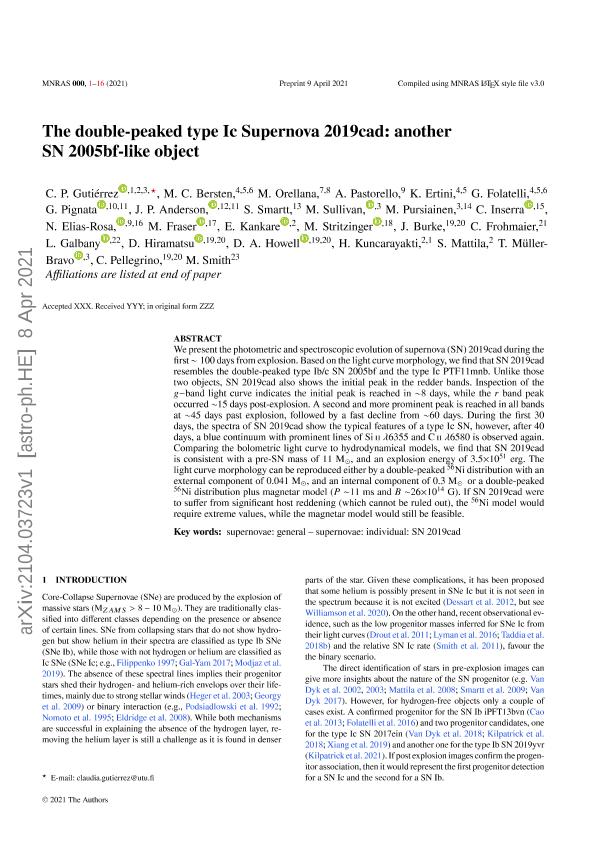Artículo
The double-peaked Type Ic supernova 2019cad: another SN 2005bf-like object
Gutiérrez, C. P.; Bersten, Melina Cecilia ; Orellana, Mariana Dominga
; Orellana, Mariana Dominga ; Pastorello, A.; Ertini, Keila Yael
; Pastorello, A.; Ertini, Keila Yael ; Folatelli, Gaston
; Folatelli, Gaston ; Pignata, G.; Anderson, J. P.; Smartt, S.; Sullivan, M.; Pursiainen, M.; Inserra, C.; Elias Rosa, N.; Fraser, M.; Kankare, E.; Moran, S.; Reguitti, A.; Reynolds, T. M.; Stritzinger, M.; Burke, J.; Frohmaier, C.; Galbany, Lluís; Hiramatsu, D.; Howell, D. A.; Kuncarayakti, H.; Mattila, S.; Müller Bravo, T.; Pellegrino, C.; Smith, M.
; Pignata, G.; Anderson, J. P.; Smartt, S.; Sullivan, M.; Pursiainen, M.; Inserra, C.; Elias Rosa, N.; Fraser, M.; Kankare, E.; Moran, S.; Reguitti, A.; Reynolds, T. M.; Stritzinger, M.; Burke, J.; Frohmaier, C.; Galbany, Lluís; Hiramatsu, D.; Howell, D. A.; Kuncarayakti, H.; Mattila, S.; Müller Bravo, T.; Pellegrino, C.; Smith, M.
 ; Orellana, Mariana Dominga
; Orellana, Mariana Dominga ; Pastorello, A.; Ertini, Keila Yael
; Pastorello, A.; Ertini, Keila Yael ; Folatelli, Gaston
; Folatelli, Gaston ; Pignata, G.; Anderson, J. P.; Smartt, S.; Sullivan, M.; Pursiainen, M.; Inserra, C.; Elias Rosa, N.; Fraser, M.; Kankare, E.; Moran, S.; Reguitti, A.; Reynolds, T. M.; Stritzinger, M.; Burke, J.; Frohmaier, C.; Galbany, Lluís; Hiramatsu, D.; Howell, D. A.; Kuncarayakti, H.; Mattila, S.; Müller Bravo, T.; Pellegrino, C.; Smith, M.
; Pignata, G.; Anderson, J. P.; Smartt, S.; Sullivan, M.; Pursiainen, M.; Inserra, C.; Elias Rosa, N.; Fraser, M.; Kankare, E.; Moran, S.; Reguitti, A.; Reynolds, T. M.; Stritzinger, M.; Burke, J.; Frohmaier, C.; Galbany, Lluís; Hiramatsu, D.; Howell, D. A.; Kuncarayakti, H.; Mattila, S.; Müller Bravo, T.; Pellegrino, C.; Smith, M.
Fecha de publicación:
07/2021
Editorial:
Wiley Blackwell Publishing, Inc
Revista:
Monthly Notices of the Royal Astronomical Society
ISSN:
0035-8711
Idioma:
Inglés
Tipo de recurso:
Artículo publicado
Clasificación temática:
Resumen
We present the photometric and spectroscopic evolution of supernova (SN) 2019cad during the first ∼100 d from explosion. Based on the light-curve morphology, we find that SN 2019cad resembles the double-peaked Type Ib/c SN 2005bf and the Type Ic PTF11mnb. Unlike those two objects, SN 2019cad also shows the initial peak in the redder bands. Inspection of the g-band light curve indicates the initial peak is reached in ∼8 d, while the r-band peak occurred ∼15 d post-explosion. A second and more prominent peak is reached in all bands at ∼45 d past explosion, followed by a fast decline from ∼60 d. During the first 30 d, the spectra of SN 2019cad show the typical features of a Type Ic SN, however, after 40 d, a blue continuum with prominent lines of Si ii λ6355 and C ii λ6580 is observed again. Comparing the bolometric light curve to hydrodynamical models, we find that SN 2019cad is consistent with a pre-SN mass of 11 M?, and an explosion energy of 3.5 × 1051 erg. The light-curve morphology can be reproduced either by a double-peaked 56Ni distribution with an external component of 0.041 M?, and an internal component of 0.3 M? or a double-peaked 56Ni distribution plus magnetar model (P ∼11 ms and B ∼26 × 1014 G). If SN 2019cad were to suffer from significant host reddening (which cannot be ruled out), the 56Ni model would require extreme values, while the magnetar model would still be feasible.
Palabras clave:
SUPERNOVAE: GENERAL
,
SUPERNOVAE: INDIVIDUAL: SN 2019CAD
Archivos asociados
Licencia
Identificadores
Colecciones
Articulos(IALP)
Articulos de INST.DE ASTROFISICA LA PLATA
Articulos de INST.DE ASTROFISICA LA PLATA
Citación
Gutiérrez, C. P.; Bersten, Melina Cecilia; Orellana, Mariana Dominga; Pastorello, A.; Ertini, Keila Yael; et al.; The double-peaked Type Ic supernova 2019cad: another SN 2005bf-like object; Wiley Blackwell Publishing, Inc; Monthly Notices of the Royal Astronomical Society; 504; 4; 7-2021; 4907-4922
Compartir
Altmétricas



